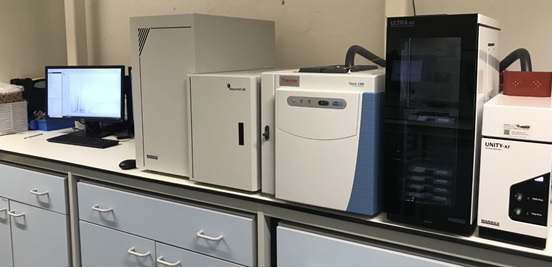Facilities
The Biomedical Sensors Laboratory is equipped with a broad range of instrumentation, including a range of different electronic nose machines. We are able to test a wide range of different medias, covering medical samples (urine, stool, breath), food and drink, manufactured parts (plastics, cloth) and air pollutants (captured or direct measurement). We provide a wide range of services to industry and academia, covering collaborative projects, application development and straight service contract/rental work. Below is a list of some of the equipment available in the lab.
IMPSEX/G.A.S. FlavourSpec
The BSL is equipped with two G.A.S. Gas Chromatograph-Ion Mobility Spectrometers. The first is a "FavourSpec" designed for lab based measurements and the second is a "BreathSpec" designed to specifically to measure human breath.
Ion Mobility Spectrometry (IMS) is an analytical technology that separates analyte mixtures into their component compounds and then detects what these compounds are. Separation of compounds is based on the specific drift times that ionised compounds need to pass a fixed distance (drift tube) in a defined electric field. The drift time of each substance is determined by the mass and geometric structure of its own ions. These parameters determine the number and rate of collisions with the drift tube walls that, in turn, impact upon the speed of transit through the drift tube. An electrometer then measures the resulting ion current as a function of time.
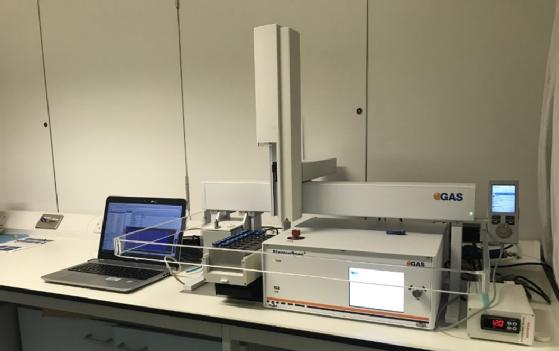
IMS is an ideal tool to analyse gaseous and liquid headspace samples. Its ultra-sensitivity and rapidity make it ideal for situations where quick results are required, when compound levels are low or where analysis is better done on-site rather than in a laboratory.
More details of this instrument can be found on the IMSPEX Website.
AlphaMOS Fox Electronic Noses
The BSL has three Alpha-MOS electronic nose instruments (Fox 4000 and two Fox 3000). Alpha-MOS was originally a spin out company that came from the fundamental electronic nose research which was undertaken initially at Warwick University. Alpha MOS develops and markets Electronic Nose (E-Nose) instruments to analyse odours and volatile compounds (VOC). In a way similar to human nose, Electronic Noses (E-Noses) allow global analysis of the headspace (volatile compounds) generated by liquid, gaseous or solid samples. These odour analysers consist of three main parts:
- Sampling system,
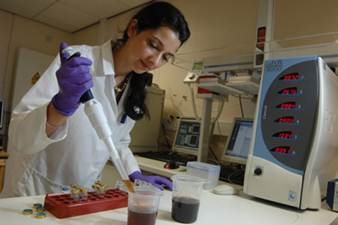
- Detection system,
- Data acquisition and processing system.
Alpha MOS has developed various models of odour analyzers that can include various sampling modes:
- Manual sampling
- Autosampler
- On-line sampling
This instrument employs an array of gas sensors (Metal Oxide Sensors or MOS) to detect gas phase chemical components within the sample. Data acquisition and processing is achieved through Alpha MOS proprietary software (Alpha Soft) using powerful multivariate statistics and chemometrics. More information on the Fox Electronic nose can be found on the Alpha-MOS website.
Sensigent Cyrano Electronic Nose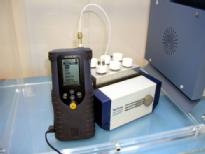
The Cyrano electronic nose (first developed by Cyrano Sciences in partnership with Warwick University), is a small, handheld electronic nose. The measurement is based on a change in resistance of each chemical sensor in the 32-sensor NoseChip when exposed to a chemical vapour. This is a differential measurement with the sensor response measured as (Rmax-Ro)/ Ro, with Ro being the resistance during a baseline gas flow and Rmax being the maximum resistance during exposure to the sample vapour.
This instrument employs composite polymer sensors (a combination of a insulating rubber and conducting carbon black, where the carbon endows conductive properties to the resultant mix). When exposed to a vapour, the polymer swell reducing the number of conductive paths through the sensor and thus increasing its resistance. This change in resistance is then used for pattern recognition software built into the Cyrano.
More information can be seen on the Cyrano Website
Owlstone Lonestar FAIMS
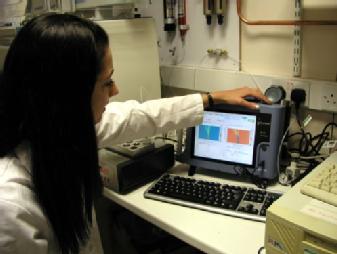 The Owlstone Lonstar FAIMS (Field Asymetric Ion Mobility Spectrometer) employs physical measurement to seperate different chemicals in a complex mixture. In these instruments, the inlet sample is first ionized. This then pass through two plates onto which is applied a asynchronous electric field. The high electric field on one of the plates cause molecules to move either towards, away or not affected by this plate. This movement is due to the fact that some molecules more faster or slower in high electric fields. A compensation volatage is also added to balance out the effect of this electric field. By scanning through a range of different electric fields and compensation voltages, it is possible to seperate a range of different chemical components.
The Owlstone Lonstar FAIMS (Field Asymetric Ion Mobility Spectrometer) employs physical measurement to seperate different chemicals in a complex mixture. In these instruments, the inlet sample is first ionized. This then pass through two plates onto which is applied a asynchronous electric field. The high electric field on one of the plates cause molecules to move either towards, away or not affected by this plate. This movement is due to the fact that some molecules more faster or slower in high electric fields. A compensation volatage is also added to balance out the effect of this electric field. By scanning through a range of different electric fields and compensation voltages, it is possible to seperate a range of different chemical components.
More details of this instrument can be found on the Owlstone Website.
1st Detect MS/MS
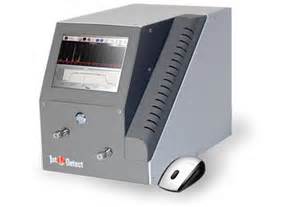
We currently have available the only 1st Detect portable mass-spectrometer in Europe, the MMS-1000. This air based instrument is able to do MS/MS analysis using air as the carrier gas and is portable/battery powered. This instrument is currently being assessed for its use in a range of different application areas.
The instrument is augmented with a pre-concentrator system, which allows PPB/PPT sensitivity.
- Mass Range: 45 – 400 amu (standard)
- Custom ranges over 15 amu to 500 amu available
- Resolution: Better than Unit Mass Scans/Sec: 1 spectra/sec (typical) 7 spectra/sec (maximum), with 14 TIC points/sec. Faster scan rates require special settings.
- Sensitivity: (measured at m/z = 91 amu xylene) Membrane Inlet 500 ppb, Preconcentrator 500 ppt using 30 sec sampling time
Weight: < 8 kg - Size: 19 cm x 33 cm x 23 cm
- MS/MS Capable: No collisional gas or buffer gas required
More details on this system can be found at the 1st Detect webpages
AIRSENSE Analytic PEN3 Electronic Nose
In addition, to our other commercial electronic noses, we are also fortunate to have a AIRSENSE Analytic PEN3 instrument. It is based on a metal-oxide gas sensor array. It has a unique dilution technique to provent overloading with substances. This extends the life time of the sensors and shortens the cycle times. This gas-flow control makes it possible to stabilize the pattern under varying concentrations and analytical conditions. Individual gases or gas mixtures are classified and recognized by a pattern recognition technique. In this case, the unit provides a quick and simple quantitative answer as good or bad, yes or no ...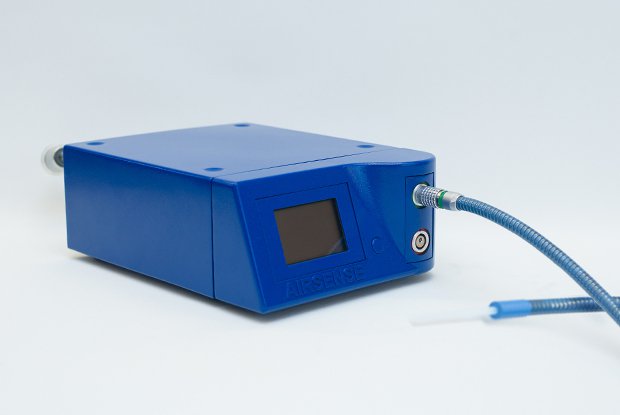
- Sensor array 10 different metal oxides single thick film sensors, optional adapted to application
- Sensor response time typical: less than 1 second Inlet Sampler special fluidic connector
- Sample flow adjustable, 10ml/min to 400ml/min Flow system internal pumps, internal sample dilution system
- Measurement time depending on the application from 4 seconds to some minutes typical: 1 minute (20s measurements, 40s zero gas)
- Sensitivity LOD 0.1 to 5ppm for gases and organic solvents, e.g. 0.1ppm H2S Display graphical display
- Dimension 255 x 190 x 92 mm Weight 2.1 k
More details can be found on the AIRSENSE website.
Gas Chromatograph / Mass Spectrometer
In addition to the range of electronic noses available in this laboratory, we also have our own dedicated Automated Thermal Desorption - Gas Chromatograph Mass Spectrometer (ATD-GC-TOF-MS) instrument to detect and identify specific chemicals within our samples. The lab has a latest generation Markes International SQ GCMS fitted with a Markes International TD100 wth Unity-xr automated thermal desorption system, attached to a BenchTOF. Using this system, we are able to identify trace level chemical components from a range of biological and non-biological samples.
